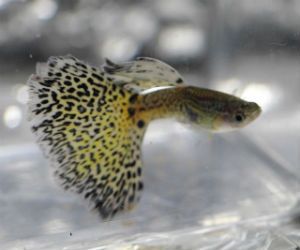
How many guppy color combinations are there in the hobby

Many people get into keeping guppies as pets because they are enamored with the fish's stunning colors, which contribute significantly to its allure. Colors are classified in the guppy universe. Platinum, metal, grass, mosaic, cobra, and tuxedo are among the options. A variety of guppy color combinations may be created using these color groups.
If you look carefully at the guppies, you'll see that they have distinct color patterns on the top and bottom halves of their bodies, respectively.
Upper body coloring of guppies
Grey is the predominate hue on the guppies' top bodies, making it easy to identify them. You can find this color in practically every pond fish, so it's hardly anything special. The term "blonde" and "golden" are both used to describe the color of the hair on top.
You'll notice that the margins of the individual scales of Tigers are darker than those of other species.
The contrast between the white top portion of the guppy and the bottom hue is stunning, even if it doesn't seem that way in other regions of the guppy.
Some guppies are labeled "albino" because they lack melanin, a pigment essential to their coloration. The red-eyed albino may be something that piques your interest. The albino eye is characterized by a reddish hue. The Real Red Eye Albino, on the other hand, has an eye that is a bright pink in hue.
The metallic color type is a deep shade that may occur in a variety of varieties, making it one of the most unusual color kinds. Occasionally, you'll notice the metallic tint covering the whole body. The platinum flashing silver guppy, with a large percentage of its body covered with silver, is another striking specimen.
Lower body coloring of guppies
The hue of the lower body is generally in stark contrast to the color of the upper body. The bottom half of the body comes in a variety of vibrant hues. It is possible for people to have different preferences when it comes to the lower body's color palette.
You may have a tuxedo guppy, which is black from the midsection down, in the lower body color. It's termed "half black" in different nations, and the color of the tuxedo varies as well.
With its snake-like design and snake-like hues, the cobra seems to be a snake.
Then there are the many solid tail lower hues, such as green, purple, or red and black. The color should be uniform throughout the tail for it to be considered a real solid.
Dots on the leopard's underside resemble those on grass, although they are considerably bigger.
All throughout the tail are little dots, as if there were grass seeds on it, which provide the illusion that the tail is covered with grass. Various strains of color exist inside this as well.
These are only some of the most common color variations, but they should give you a better sense of what to look for when selecting guppies for your breeding program.